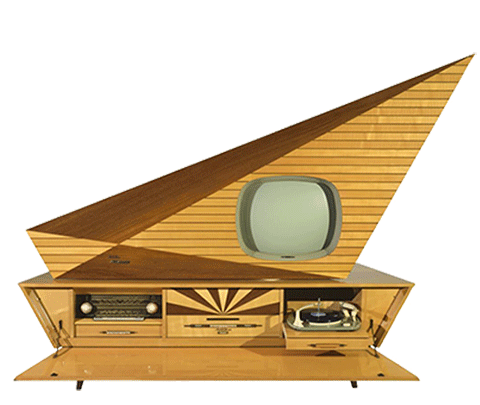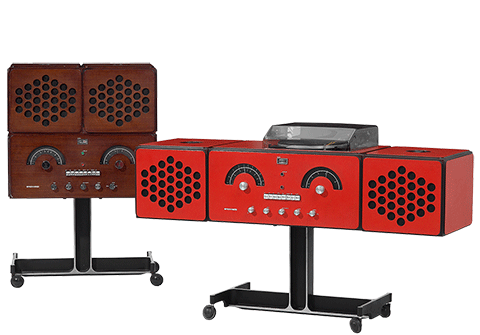
Is furniture getting smaller and more flexible because there is a megatrend called “mobility”? Such questions will be answered at the imm cologne and the Passagen, starting from 18 till 24 January.
Photo © Karsten Jipp, Koelnmesse/Thonet How to live? To build? To reside?
|
|
by Thomas Wagner
Jan 12, 2016 In Cologne, furniture, designers and manufacturers are once again taking the stage and about to go on air, broadcasting loudly Look! or Listen! Depending on where you happen to be standing in the trade-fair complex. You can close your eyes, but not your ears. Today, it’s all about attention grabbing. At trade fairs, everyone is clamoring for attention. Sounds, voices, words, music, melodies reach out to us, and not just in the trade-fair halls, not only directly, but also indirectly through the ether. For example, the media always play along when the show quite literally hits the stage. In fact, the Greek God Pan (half man, half goat, a God of the Ears, who loved music and dance) was said to have dissolved into vibrating air. While our eye switch madly with much effort from here to there and back again, trying to compose a coherent image from disparate views, it is sound that cloaks us, makes us the center of the world. Evidently someone at the Cologne Museum of Applied Art, the MAKK, thought it was time to give visitors to the international furniture trade fair more than just something visual to think about. “RADIO Days – Tube Radios, Design Classics, Internet Radio” is the name of an exhibition dedicated to radio as the first mass medium as it were and to the device’s checkered history – from the simple wooden box outfitted with a receiver to active, Internet-ready loudspeakers. The latter, not that unlike the first radios, seemingly generate what we want to hear in the form of a flow from nowhere. About 200 examples, including devices by Hans Gugelot, Dieter Rams, Achille and Pier Giacomo Castiglioni, Raymond Loewy and Verner Panton are on display, chronologically structured in 20 stages and interiors typical of the day. And into the bargain there are listening stations with historical recordings from radio archives. The shape of the furniture designed to house the first radios, music boxes and hi-fis do not irritate the eye. They all concur with the form and function of the day. However, in the spirit of Pan we could instead ask why actually no one has yet wondered whether and how design sounds, be it successful or less so? Could we ask not just as regards world receivers and radio phonographs whether and how acoustic and visual sounds calibrate in them? Does design even have a sound? How to discern it in an age when the significance of “hardware” is swiftly dwindling? Perhaps that’s just hearsay, too. Be that as it may, at the beginning of the year there are those silent moments when it would be so nice to think that time has stood still and everything will turn out for the better. The daily news broadcasts show just how deceptive this is. “How to live?” an exhibition at Ludwigshafen’ Wilhelm Hack Museum asks, and reminds us of the images of tomorrow innate in art, architecture and design from Malevich to Fujimoto. Currently, not much by way of encouragement is to be heard in this regard from the architects and urban planners, not to mention the sociologists, designers and politicians. How to build? How to live? Where to find the space? How to design it with social equity in mind? How to pay for all this? The urgency of such questions really jumps out at you. Especially as there’s a housing shortage, rents in conurbations are soaring, and there are hundreds of thousands of refugees arriving on the doorstep. These are the conditions under which the imm cologne is taking place. For a trade fair that takes the trinity of “Create. Furnish. Live.” as its creed and says of itself that it presents "the trends that will be shaping the furniture and interiors sector – and the products that are good for business” hardly an easy state of affairs. Trends and business, now that is a self-description of disarming honesty. Trade fairs in general and furniture trade fairs in particular are always per se paradox events or hybrids as it were: They not only present things, but also products that need to gain sway in the market. They seek not only to kindle our enthusiasm for new, innovative, attractive, exciting, beautiful and surprising things, but also to help secure the objects’ economic success. And they function a bit like those off-the-shelf picture clip frames: The shape and thrust remains more or less the same, but the picture they present changes. The imm cologne itself has in recent years evolved from a seemingly urban sparrow whose habitat seemed endangered into an attractive colorful parrot. Exhibitors have returned, new formats successes launched (including the Stylepark-curated Featured Editions) and presentation modes optimized. Thus, this year the organizers are again upholding their established categories of Pure, Pure Editions, Pure Talents, Comfort, Prime, Sleep, Smart and Global Lifestyles and even the holistic worlds of the LivingInteriors. And it has also proved invaluable that the Design Post, which celebrates its 10th anniversary this year, has moved closer to the throb of the fair. In the long run it will hardly suffice to leave the frame unchanged, however, and the manufacturers and designers in charge of handling the new challenges. Without doubt, in the large shop windows of our feel-good zone there are all manner of trends and interior ideas for any and all rooms, styles, tastes and standards. But we must ask whether that suffices when conditions change? Can a concept such as “The House – Interiors on Stage” (in the Pure Editions Hall 2.2) actually, as the trade fair itself claims, deal “not just with contemporary furnishing trends but also with people’s aspirations as well as social change”? To date, at least, “Das Haus” has been more of a showcase for selected manufacturers and products than a coherently structured interior concept. Less stage and a greater sense of reality would certainly be a good thing here in the future. Unlike the trade fair, proper, the accompanying program “Passagen – Interior Design Week Cologne”, which is spread all over town, looks increasingly affected by ennui. Only rarely are other presentation modes tested or surprising things displayed. Here, above all, an effort must be made to regain lost terrain. Things are at least alive and kicking in the rooms at the Kunstverein. In the person of Jasper Morrison a worthy „A&W Designer of the Year” has been chosen, whose oeuvre is on show, and even the German Design Council has chosen here as the venue for the Best of the Best in its Iconic Awards. All that is of course also simply a matter of shoring up the given. The “megatrends” that the trade fair has identified, and there are 11 of them ranging from connectivity and silver society via mobility and health to individualization, globalization and new learning, hardly help much, either. Topics such as interiors for the senior citizens and networking have at least been spotted and are being addressed, albeit how concretely is a different matter altogether. If one takes all the megatrends together, then they are simply names for phenomena that typify life today. They all overly easily obey a simple stimulus/response scheme and seem so general that it is hard not to think everything is going round in circles. Is furniture getting smaller and more flexible because there is a megatrend called “mobility” or does the trend exist because furniture is getting smaller and more flexible? Be that as it may, looking forward to seeing you in Cologne. And keep your ears peeled! Kölnischer Kunstverein > A&W-Designer 2016: Jasper Morrison > German Design Council In the movie theater at the Kunstverein MAKK – Museum für Angewandte Kunst Köln Design Post PASSAGEN – Interior Design Week Cologne |

On show at „Radio Days“ at Cologne’s MAKK: “Volksempfänger VE 301 Wn“, Walter Maria Kersting, Mende & Co., Dresden (DE), 1933-37, © MAKK, photo: RBA Köln, Marion Mennicken

“602 A”, Raymond Loewy, Emerson Radio and Phonograph Corp., New York City, New York (US), 1949, © Collection Winkler, MAKK, photo © Saša Fuis Photographie, Cologne

“CFS-W365S”, Sony, Tokio (JP) 1987, © Manuela Cirillo Karpf, photo: RBA Köln, Marion Mennicken

“Komet“, Kuba-Imperial, Wolfenbüttel (GER), 1957-58, © Haus der Geschichte, Bonn,
photo: Ralf Röttjer 
“Phonosuper SK 5“, Hans Gugelot, Dieter Rams, Max Braun oHG, Frankfurt a .M. (GER), 1958, © MAKK, photo: RBA Köln, Marion Mennicken

“RR126 OFST, Deposito”, Achille Castiglioni, Pier Giacomo Castiglioni, Brionvega S.p.A., Milano (IT), 1965-66, © Collection Winkler, MAKK, photo: Saša Fuis Photographie, Cologne

“Ekco AD 65”, Wells Coates, 1932, Erik Kirkham Cole Limited, Southend-On-Sea (GB), 1934, © Collection Winkler, MAKK, photo: Saša Fuis Photographie, Köln

“Violetta 300“, Lumophon, Nürnberg (GER), 1968-72, © Volker Schaeffer, photo: RBA Köln, Marion Mennicken

“T 1000 Weltempfänger“, Dieter Rams, Braun AG, Frankfurt a .M. (GER), 1964, © Collection Winkler, MAKK, photo: Saša Fuis Photographie, Cologne

“LA 42 Tykho”, Marc Berthier, Lexon, Boulogne-Billancourt (F), 1998, © MAKK, photo: RBA Köln, Marion Mennicken

“Walky Box”, Supertech Deutschland GmbH, Nettetal (GER), 1990, © Marion Brass, photo: RBA Köln, Marion Mennicken
|








